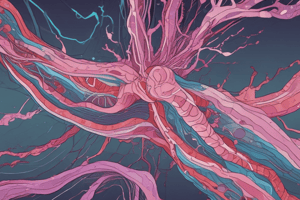Podcast
Questions and Answers
What is the role of calcium in the Excitation-Contraction Coupling process?
What is the role of calcium in the Excitation-Contraction Coupling process?
- Triggers the release of calcium from the T-tubules
- Stimulates myosin to bind ATP
- Inhibits the action potential propagation
- Activates the ryanodine receptor to release stored calcium (correct)
What happens when myosin binds another ATP molecule?
What happens when myosin binds another ATP molecule?
- It enters a state of rigor mortis
- It detaches from actin (correct)
- It activates the T-tubules
- It binds stronger to actin
What occurs during the latent period of a twitch contraction?
What occurs during the latent period of a twitch contraction?
- Tension increases but not visibly
- Peak tension is reached
- Myosin binds to actin
- AP propagation along T-tubules (correct)
How does an action potential contribute to muscle contraction?
How does an action potential contribute to muscle contraction?
What is the significance of the Cross-Bridge Cycle in muscle contraction?
What is the significance of the Cross-Bridge Cycle in muscle contraction?
When does muscle relaxation occur?
When does muscle relaxation occur?
What is the main reason for using acetylcholinesterase inhibitors in treating certain conditions?
What is the main reason for using acetylcholinesterase inhibitors in treating certain conditions?
Why are glucocorticoids sometimes used in treatments related to neural causes?
Why are glucocorticoids sometimes used in treatments related to neural causes?
In smooth muscle cells, what is responsible for anchoring thin filaments in place during contraction?
In smooth muscle cells, what is responsible for anchoring thin filaments in place during contraction?
What is the characteristic feature of smooth muscles that distinguishes them from skeletal muscles regarding their striped appearance?
What is the characteristic feature of smooth muscles that distinguishes them from skeletal muscles regarding their striped appearance?
In smooth muscle contraction, which protein directly binds with calcium ions to initiate the process?
In smooth muscle contraction, which protein directly binds with calcium ions to initiate the process?
What type of electrical activity allows some smooth muscle cells to generate action potentials without external signals?
What type of electrical activity allows some smooth muscle cells to generate action potentials without external signals?
What is the term for muscle contraction that produces tension and causes the muscle to change length?
What is the term for muscle contraction that produces tension and causes the muscle to change length?
What happens to the muscle length in eccentric contraction?
What happens to the muscle length in eccentric contraction?
What type of contraction occurs when the muscle changes tension but the length of the muscle stays the same?
What type of contraction occurs when the muscle changes tension but the length of the muscle stays the same?
What is the effect of increasing load on shortening velocity of a muscle?
What is the effect of increasing load on shortening velocity of a muscle?
What does passive tension in a muscle refer to?
What does passive tension in a muscle refer to?
What happens to the tension in a muscle if a second action potential is produced before the muscle relaxes from the first?
What happens to the tension in a muscle if a second action potential is produced before the muscle relaxes from the first?
Flashcards are hidden until you start studying




